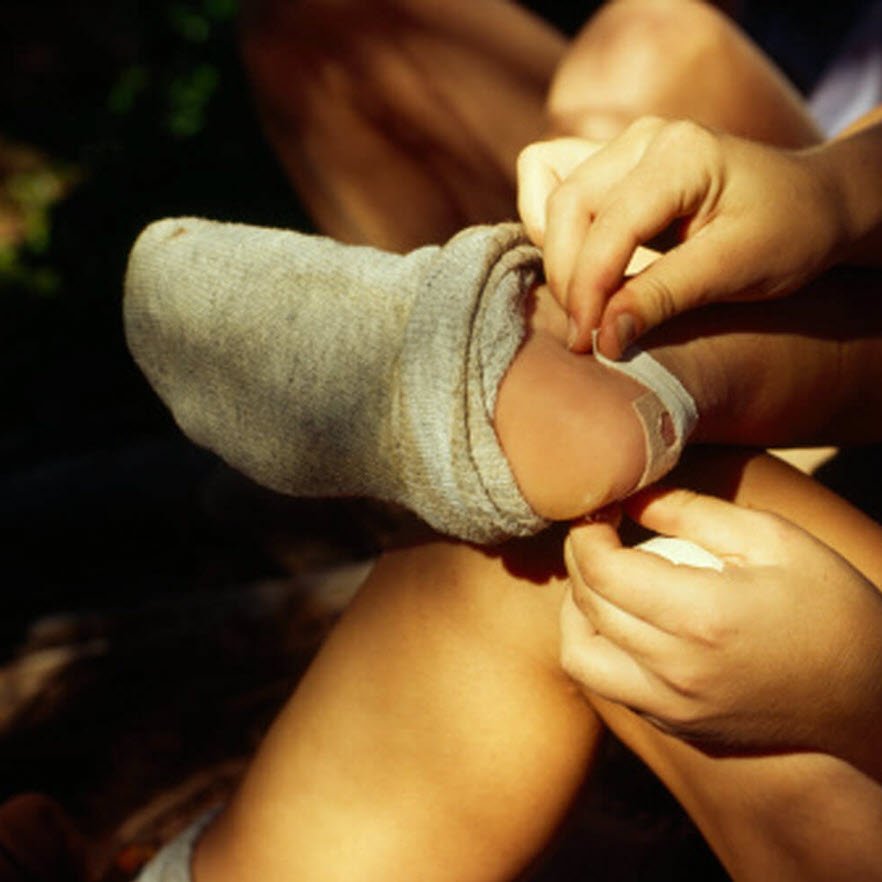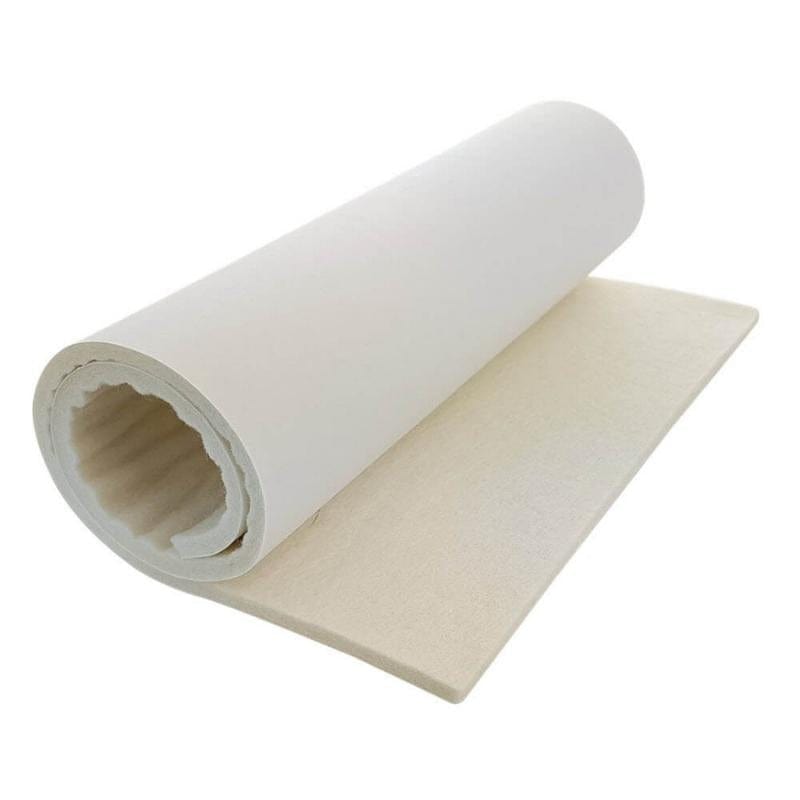Ask a bunch of people what products they have in their blister kits. I'd guess 100% of them will say moleskin. Blister moleskin is certainly a stalwart of the blister management scene. So, it might surprise you when I say I think it's a bit over-rated. Why? Because if you asked that same bunch of people how moleskin works on blisters, I reckon 99% of them would say "moleskin stops friction". Personally, I don’t think moleskin reduces friction. In fact, I think it probably increases friction. This may be a controversial stance. Let me explain.
First, What is Blister Moleskin?
The definition of moleskin according to the Merriam Webster dictionary is:
- the skin of the mole used as fur
- a) a heavy durable cotton fabric with a short thick velvety nap on one side b) a garment made of moleskin - usually used in plural c) adhesive padding (as for blisters) made of moleskin
Of course, we’ll be zeroing in on definition 2c - the moleskin that's used for blisters which is an adhesive-backed cotton fabric.
Wikipedia Definition
However, let’s just be sure of this definition by checking Wikipedia. I’ve highlighted a few words for the sake of clarity:
“Moleskin is a heavy cotton fabric, woven and then sheared to create a short, soft pile on one side. The feel and appearance of its nap is similar to felt or chamois, but less plush than velour. The word is also used for clothing made from this fabric, as well as adhesive pads stuck to the skin to prevent blisters.” “Structure: Moleskin is woven of carded cotton yarn in a dense weft-faced satin weave. The surface is napped or sheared to "produce a suede-like finish". “Medical: Moleskin fabric can be coated with an adhesive backing and used to prevent or treat friction injuries of the feet. In the case of a blister, the moleskin is cut with a hole in the centre so the fabric does not adhere to the blister directly. The thickness of the surrounding moleskin protects the blister from further friction.”
How Are We Going So Far?
So moleskin is still an adhesive-backed cotton fabric. And Wikipedia says it is used in blister prevention and/or in blister treatment, depending on which paragraph we read. Just to hammer home the “cotton” message, here are a couple of images from moleskin packaging and product listings. Here, moleskin is also described as “cotton flannel”.
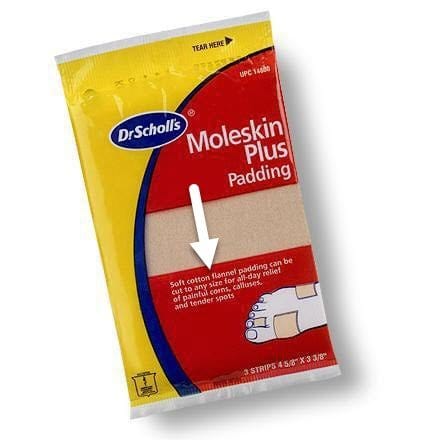
Moleskin is a "soft cotton flannel"
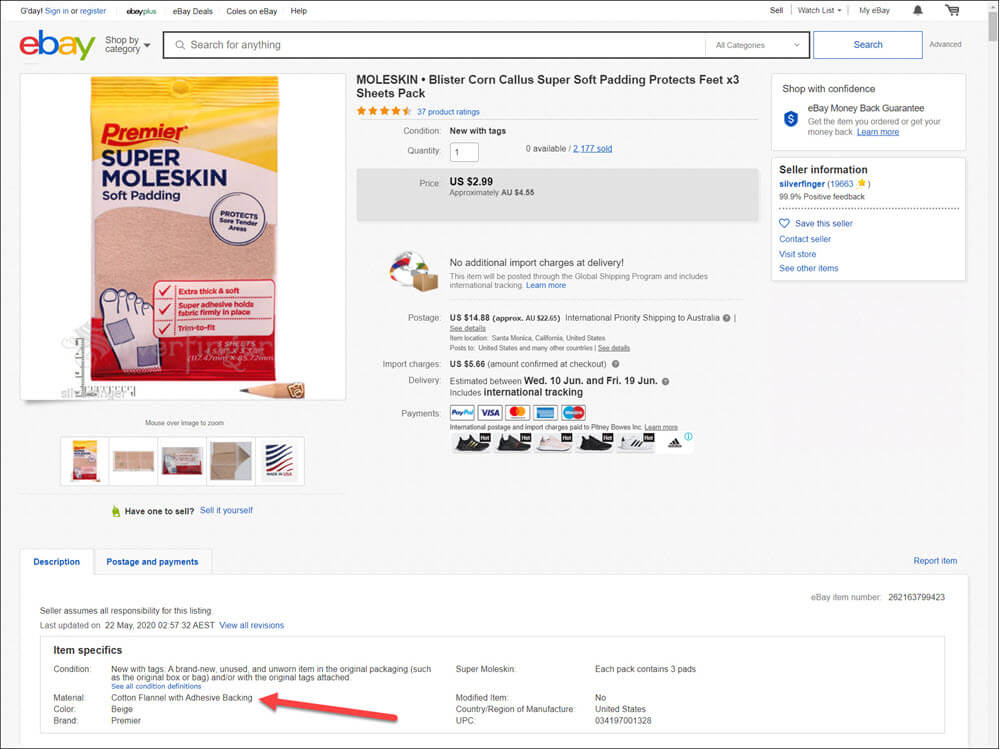
Moleskin is "cotton flannel with adhesive backing"
Moleskin For Blisters Is Made From Cotton
Do you see where I’m coming to with this focus on “cotton”? If you’ve bothered to read this far, you’re probably someone who knows cotton is not a good material to use when it comes blisters. It’s the first thing anyone will tell you when you're buying socks. “Make sure they’re not cotton”. Why? Because cotton is an hydrophilic (water-attracting) material. By attracting water, it increases friction levels. Now think about this. Why would you want to adhere a material that promotes high friction levels to a notoriously sweaty part of your body that frequently experiences blisters? Especially if your aim is to reduce blister formation?
Is Moleskin Really a Good Idea For Blisters?
Let’s unpack this a little more. Firstly, I fully agree that moleskin stops anything from rubbing the skin. Get some sand in your shoe and you can be pretty sure the skin under your moleskin won’t be bothered by it. But sand doesn’t cause blisters – it causes abrasions. Abrasions are a superficial-to-deep wear injury to the skin. Blisters aren’t. Blisters are a shear stress injury under the surface of the skin caused by repetitive high shear distortions. This distinction is a very important one to make because the two are very different skin injuries.
Secondly, remember that when we talk about friction, we’re not talking about rubbing. We’re talking about the friction in the “physics” sense. Friction is the resistance to the movement of one surface across another. High friction levels means more sticky, and low friction levels mean slippery. As a result, high friction levels cause higher shear distortions within the skin which is what leads to blisters. Low friction levels prevent high shear distortions and therefore prevents blisters.
Here's The Important Bit
Let's apply this to a moleskin on your foot situation. Let's look at the friction levels at each of the interfaces.
Skin-Moleskin Friction Level:
So, we’ve got an artificially massively high friction level between the skin and adhesive side of the moleskin. No problem, that’s how adhesive works. As long as the “cotton” business-side of the moleskin works, we’re all good.
Moleskin-Sock Friction Level:
Unfortunately, this is where things fall over. Thanks to the cotton side of the moleskin, we’ve got an elevated friction level between the moleskin and the sock. I say elevated because the skin-sock interface we’ve just changed to a cotton-sock interface will almost certainly present higher friction levels thanks to its propensity to absorb the sweat produced by the millions of sweat glands on the skin of our feet. At least with a moisture-wicking sock, that sweat could have been wicked away.
Sock-Shoe Friction Level:
Then, the sock-shoe friction level will remain unchanged.
Net Result:
By using moleskin for blisters on your feet, we haven’t reduced friction levels anywhere. In fact, we’ve increased them. Compared to a normal skin-sock-shoe friction scenario, we’ve increased friction levels thanks to: 1) adhesive and 2) cotton. This is the set-up for high shear stresses in the skin, intraepidermal delamination (tears in the stratum spinosum of the epidermis) and the formation of blisters. This half explains my assertion that moleskin doesn’t reduce friction levels, and in fact, increases them. Now here’s some research.
Comparing Friction Level of Moleskin to Other Products
There’s not a lot of friction data around when it comes to foot skin and footwear. We're looking for friction data for the materials used in blister products, socks, shoe linings, insole and orthotic covers. It’s a shame companies don’t make this available. And it's a shame this doesn’t attract more academic research. I'd love to see a comparison of the friction properties of various tapes used in blister prevention (paper tape, Leukotape , Leukoplast , RockTape , Fixomull Stretch etc so we could compare it to moleskin ). However, there is some data.
Friction in Dry Conditions
Here’s a study that compared the friction levels (coefficient of friction) of some blister treatment products. Specifically, blister dressings. This was done in dry conditions. The second and third products are different brands of moleskin. There’s quite a difference between the two. But on the surface of it, moleskin is looking pretty good (at least in the dry conditions of this study). Most of the other blister dressings have much higher friction levels.
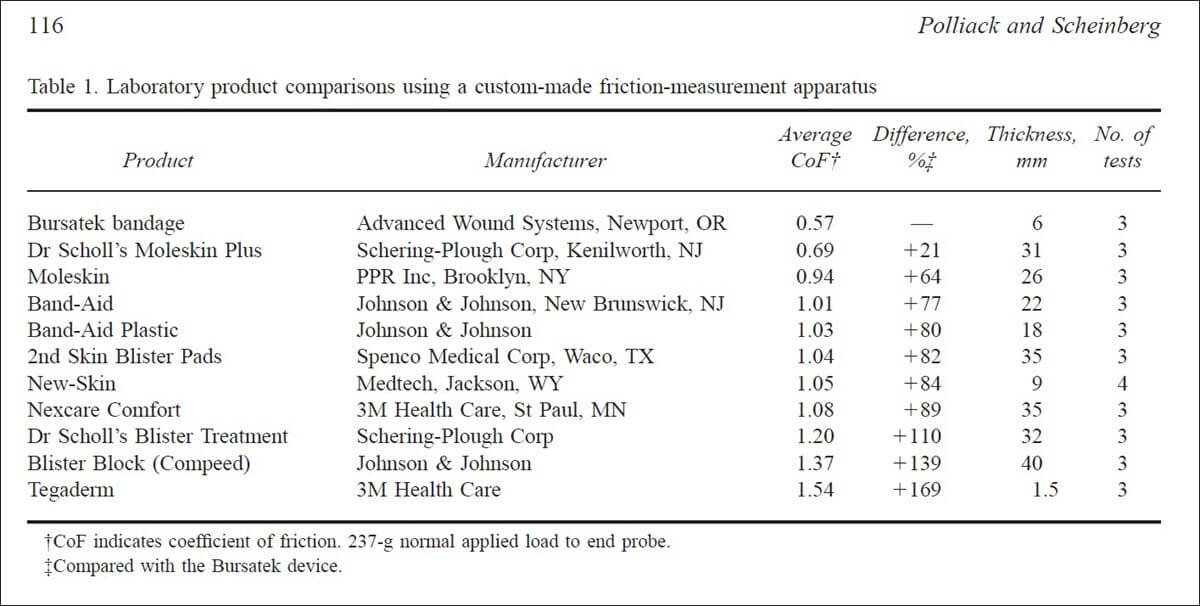
Polliack, A and Scheinberg, S, (2006). A New Technology for Reducing Shear and Friction Forces on the Skin: Implications for Blister Care in the Wilderness Setting. Wilderness and Environmental Medicine, 17, 109—119
Friction in Dry and Wet Conditions
Now here’s some data comparing friction levels (coefficient of friction) of materials used in orthotics and prosthetics. It’s really important to use materials to effect low shear distortions at amputation stumps and foot ulcers. What’s really handy about this study is it compared the same materials in dry and wet conditions. See how almost every material shows a higher friction level when wet? Look for moleskin and you'll see it has the highest friction level of all of the materials tested. It’s 0.63 dry and 0.87 when wet.
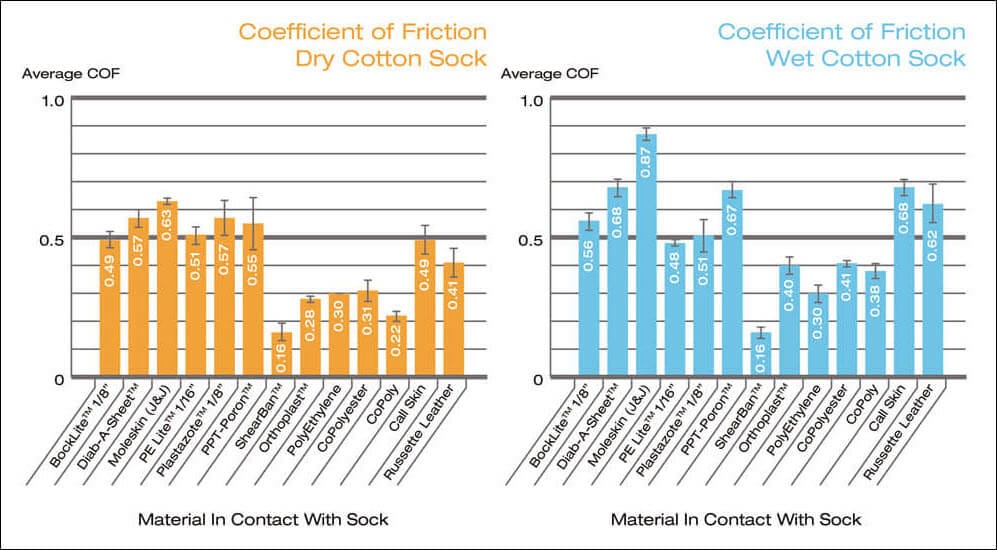
Carlson, JM. 2006. CPO Functional Limitations From Pain Caused by Repetitive Loading on the Skin: A Review and Discussion for Practitioners, With New Data for Limiting Friction Loads, JPO Journal of Prosthetics and Orthotics: October - Volume 18 - Issue 4 - p 93-103
Compare moleskin in the graphs above to some other materials you might know. If none of these are familiar, let me point out two that I use for blister prevention and treatment.
PPT-Poron
Poron is a good cushioning material used by podiatrists for lots of things including blister prevention. We don’t use it for its friction properties, we use it for pressure-reduction and shear absorption. The point to make here is, if you’re using moleskin to cushion or as donut pads, you can do much better. You’ll get lower friction levels, far lower peak pressures and some shear absorption with Poron. There’s even reasearch that shows an alternative product called Spenco, one that we use for insoles and orthotic covers, performs even better than Poron at reducing blister formation (Spence and Shields, 1968).
A Word About Moleskin Donut Pads and Other Forms of Pressure Deflection
Based on my own blister experience, 25+ years of dealing with pressure lesions on other people's feet using various types and thicknesses of deflective padding, and research findings, I can tell you, the thickness of moleskin is insufficient to provide significant pressure relief to any foot blister when fashioned as a donut pad. Even if you double it up, it’s still not going to be very thick. If you want to make a decent donut pad to deflect pressure, you'll need something much thicker, like orthopaedic felt (Raspovic et al, 2016; Curren et al, 2015; Nieto-Gil et al, 2019; Zimny et al, 2001). My favourite thickness is 7mm. Research shows that 7mm performs significantly better than 5mm deflective padding at reducing peak pressure. The average thickness of moleskin is around 2mm.
ShearBan
Shearban is also known as Engo Blister Patches. This is a fabulous long-lasting friction-reduction product that I sell from my online store. I use it in my own shoes for my blister-susceptible areas, for the runners I help at ultramarathon events, and for my patients with foot ulcers. The point to make here is, if you’re using moleskin to reduce friction, this is a reason to move on from moleskin. You’ll get way lower friction levels with ShearBan/Engo patches, and those friction levels don’t increase with moisture – great if you’re a heavy sweater or your feet get wet from environmental sources (wet grass, rain, river crossings).
Checking in again
Based on what you’ve seen so far, do you agree it is highly unlikely that moleskin reduces friction levels? Based on what you’ve seen so far, do you agree it’s more likely that moleskin actually increases friction?
- Yes? Cool, we’re on the same page.
- No? Tell me why in the comments. Give me some research or a cohesive theoretical framework for me to consider. Tell me something I don't know. I'm happy to be proven wrong.
How Does Moleskin Work For Blisters?
There is no doubt moleskin provides some relief for some people with their hot-spots and blisters. The question is, if it doesn’t reduce friction, where does this relief come from? The best way to describe how moleskin works is, by spreading shear load across a larger area of skin. Exactly like tape does. In fact, I refer to moleskin as a tape. That’s really all it is. It’s a thick-ish cotton tape. Instead of the shear distortions being confined to the blister-susceptible area, with moleskin in place, shear is spread over the area the moleskin is applied to. An important part of moleskin application, whether intentional or not, is to apply it to an area larger than the blister itself. The bigger the better. And, the more rigid the better. Let me explain.
It's All In The Stiffness
There are lots of different brands of moleskin for blisters. They vary with their thickness, the effectiveness of their adhesive, their friction level (as we’ve seen in the table by Polliack and Scheinberg). Most importantly, they differ in their stiffness (rigidity). When it comes to spreading shear load, rigid works best. They spread shear load better. Flexible stretchy moleskin (more like a fleecyweb or any flexible tape like Fixomull Stretch) can’t spread shear load as well. However, they are easier to apply to curvy areas like the toes and over bunions. This concept of spreading shear load over a larger surface area thereby reducing shear load per unit area is a relatively new one. It was first described in 2013 by Carlson (personal communication: Rushton, 2013) and later by Hoffman (2016) and Rushton (2019). Learn more about how taping works with blisters, including taping technique video demos.
Buying Moleskin
If you want to buy some moleskin, go into the pharmacy and see if you can figure out if you’re getting rigid or flexible (remember, go with rigid). Or take a look at this list of moleskins available on Amazon.com. Someone gets an affiliate commission if you click through and purchase from this list – not me. It’s just a good list just to share to give you a feel for some different types. You can always ask a question to the seller about whether it’s rigid or flexible before you buy it.
How Do You Use Moleskin For Blisters?
It depends whether you’re using it to prevent blisters or treat them.
Moleskin Blister Prevention:
It's best to apply it as if it were a tape. Apply it over a large area like the image below. Again, refer to the blister taping post for videos demonstrating taping techniques.
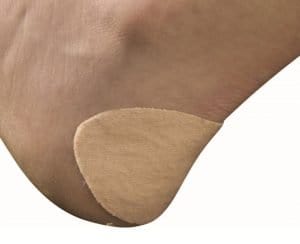
Moleskin to prevent blisters at the back of the heel
Moleskin Blister Treatment:
The idea here is you have a piece of moleskin with a hole in the middle, slightly bigger than your blister. You place it so there’s nothing sticking to the blister itself. Some people leave it there. Some apply some antiseptic. Others cover the whole thing with another piece of moleskin (or just some tape). Here's the best article explaining the donut pad process.
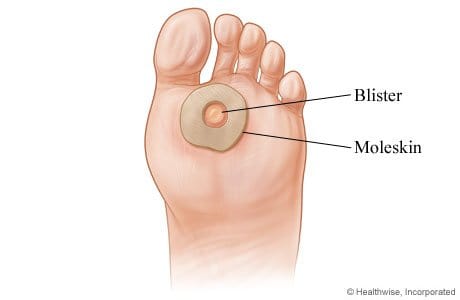
Moleskin donut pad
Be Careful With Your Blister Roof
If you're using moleskin on an already-formed blister, make sure you don’t stick it directly to your blister. The the last thing you want to do is rip the roof off your blister. Instead, put an island dressing on it for protection, a bit of cushioning and to absorb any fluids coming from the blister. I’ve written about this at length here if you want to learn more.
Conclusion
Moleskin! It stops sand and grit from abrading your skin. And the rigid ones spread shear load. This is how moleskin helps with blisters. But moleskin does not reduce pressure much at all and it definitely does not reduce friction.
References
- Rushton, RJ. 2020. Exploring the Mechanism for Blister Prevention Using Moleskin, Current Sports Medicine Reports: Volume 19, Issue 11, p 451-453 doi: 10.1249/JSR.0000000000000768
- Carlson, JM. 2006. CPO Functional Limitations From Pain Caused by Repetitive Loading on the Skin: A Review and Discussion for Practitioners, With New Data for Limiting Friction Loads, JPO Journal of Prosthetics and Orthotics: October - Volume 18 - Issue 4 - p 93-103
- Curran, MJ, Ratcliffe, C and Campbell, J. 2015. A comparison of types and thicknesses of adhesive felt padding in the reduction of peak plantar pressure of the foot: a case report. Journal Of Medical Case Reports. 9: 203
- Gotta, A and Wilson, D. 2018 Healthline: https://www.healthline.com/health/moleskin-for-blisters
- Hoffman, MD. 2016. Etiological Foundation for Practical Strategies to Prevent Exercise-Related Foot Blisters. Current Sports Medicine Reports: Volume 15, Issue 5: 330-335
- Johnson, J. Greenbelly: https://www.greenbelly.co/pages/moleskin-for-blisters
- Merriam-Webster Dictionary: https://www.merriam-webster.com/dictionary/moleskinPolliack, A and Scheinberg, S. 2006. A New Technology for Reducing Shear and Friction Forces on the Skin: Implications for Blister Care in the Wilderness Setting. Wilderness and Environmental Medicine, 17, 109—119
- Nieto-Gil, MP, Ortega-Avila, AB, Pardo-Rios, M and Gijon-Nogueron, G. 2019. Effectiveness and Duration of Plantar Pressure Off-loading by Two Designs of Felt Padding: A Preliminary Study. Journal Of The American Podiatric Medical Association. Nov; 109(6):431-436
- Raspovic, A, Waller K and Wong, WM. 2016. The Effectiveness of Felt Padding for Offloading Diabetes-Related Foot Ulcers, at Baseline and After One Week of Wear. Diabetes Research and Clinical Practice. Nov; 121:166-172
- Rushton, R. 2013. The Advanced Guide to Blister Prevention. 1st ed. , Chapter 6: Taping. Available from: https://www.blister-prevention.com/pages/the-advanced-guide-to-blister-prevention-2013.
- Rushton, R. 2019. Tape Use to Prevent Blisters: Does It Really Do What We Think It Does? Lower Extremity Review. March.
- Spence WR and Shields MN. 1968. Prevention of blisters, callosities and ulcers by absorption of shear forces. Journal of the American Podiatric Medical Association. 58: 428-34
- Wikipedia: https://en.wikipedia.org/wiki/Moleskin
- Wikipedia: https://en.wikipedia.org/wiki/Polyethylene
- Zimny, S, Reinsch, B, Schatz, H and Pfohl, M. 2001. Effects of Felted Foam on Plantar Pressures in the Treatment of Neuropathic Diabetic Foot Ulcers. Diabetes Care. Dec; 24(12): 2153-2154
